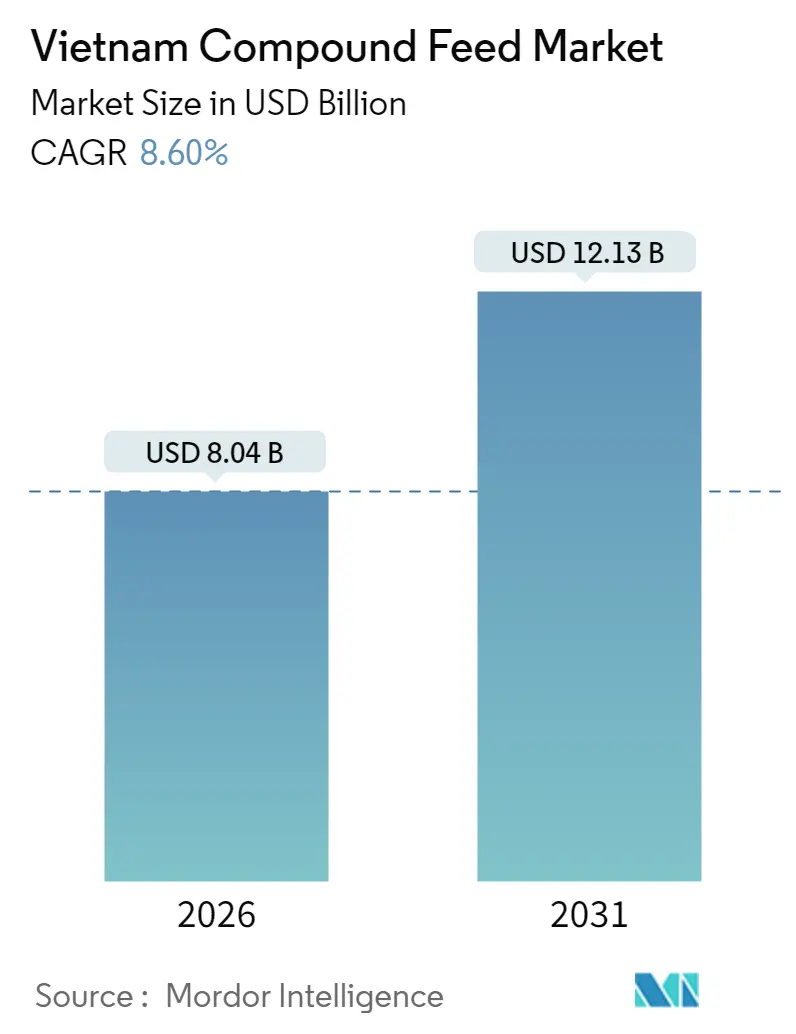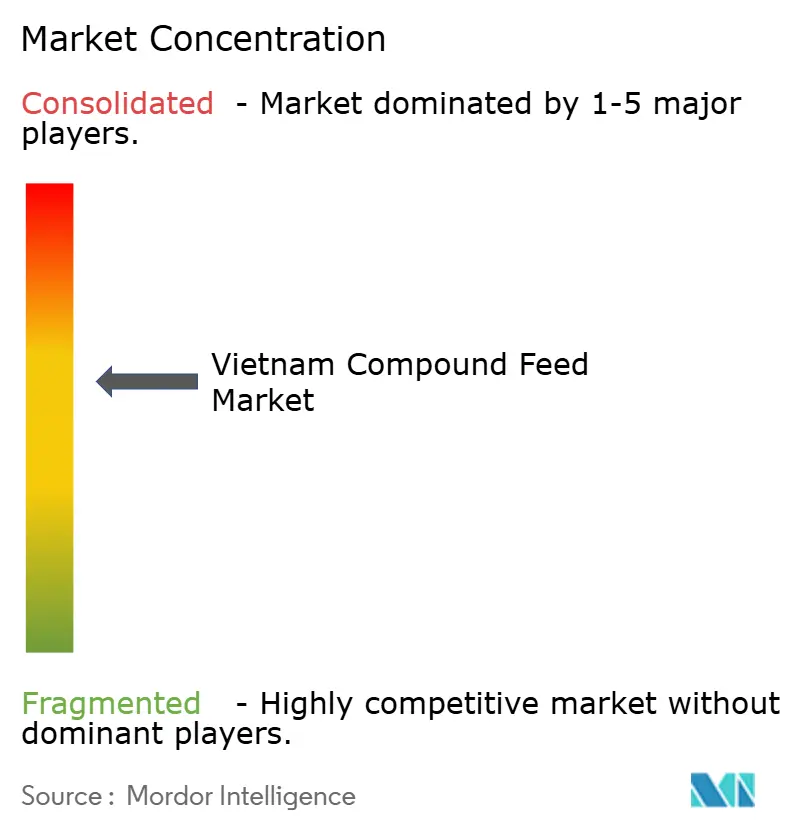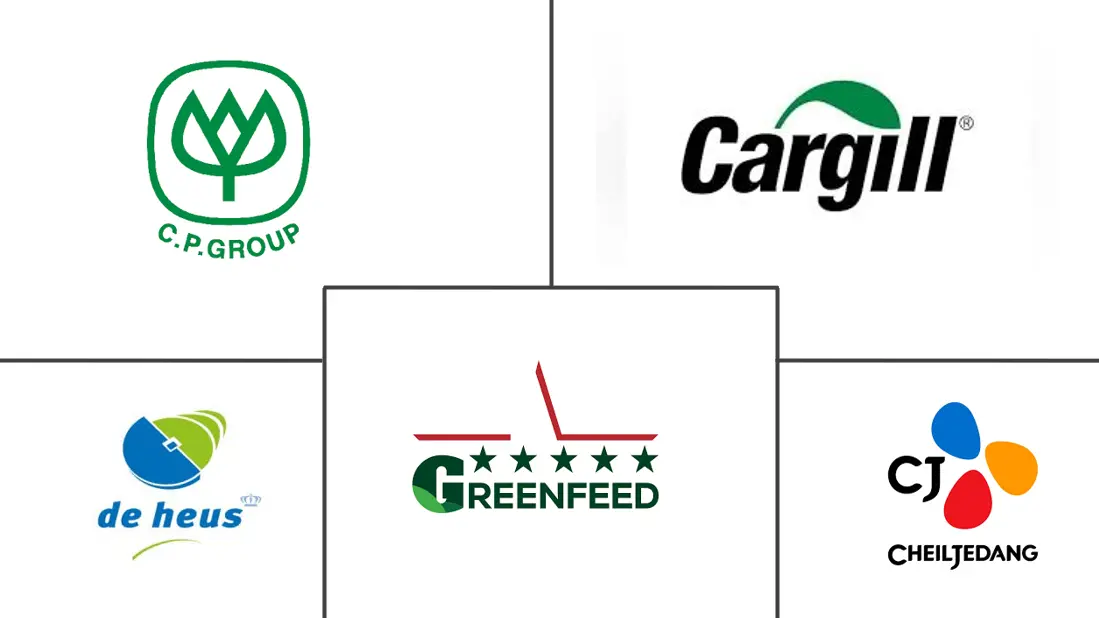
Vietnam Compound Feed Market Analysis by Mordor Intelligence
The Vietnam compound feed market is expected to grow from USD 7.40 billion in 2025 to USD 8.04 billion in 2026 and is forecast to reach USD 12.13 billion by 2031 at 8.6% CAGR over 2026-2031. Vietnam has emerged as Southeast Asia's fastest-growing feed market, supported by its recovery from African Swine Fever and its development as a regional aquaculture export center. The market demonstrates strength through the adoption of integrated farming models and government initiatives to decrease reliance on imported feed ingredients, which currently represent 80% of raw material requirements. The industry consists of 265 feed manufacturing facilities, including 85 foreign-invested enterprises and 180 domestic producers, creating a distinct two-tier competitive landscape[1]Source: Ministry of Agriculture and Rural Development, “Livestock Industry Development Report 2024,” MARD.gov.vn . The gap between large-scale producers and smaller mills continues to widen due to integrated farming models, increased contract farming adoption, and digital nutrition platforms. Additionally, the introduction of functional additives and specialized aquafeeds has increased average selling prices and profit margins as farmers recognize that investments in animal health reduce disease risks.
Key Report Takeaways
- By ingredient type, grains and cereals held 45.60% of the Vietnam compound feed market share in 2025, while supplements are forecast to record a 9.1% CAGR through 2031.
- By animal type, poultry accounted for 33.70% of the Vietnam compound feed market size in 2025, and aquaculture is projected to advance at an 8.7% CAGR to 2031.
- Charoen Pokphand Group Co., Ltd, Cargill Incorporated, Royal De Heus Group B.V., GreenFeed Group JSC, and CJ CheilJedang Corp are primarily the largest players in the Vietnam compound feed market.
Note: Market size and forecast figures in this report are generated using Mordor Intelligence’s proprietary estimation framework, updated with the latest available data and insights as of January 2026.
Vietnam Compound Feed Market Trends and Insights
Drivers Impact Analysis
| Driver | (~)% Impact on CAGR Forecast | Geographic Relevance | Impact Timeline |
|---|---|---|---|
| Rising meat and seafood consumption | +2.1% | National, stronger in urban centers | Medium term (2-4 years) |
| Emphasis on animal health and functional nutrition | +1.8% | National, commercial farming regions | Long term (≥ 4 years) |
| Expansion of integrated mega-farms and contract farming models | +1.5% | Mekong Delta, Red River Delta, and Central Coast | Medium term (2-4 years) |
| Growth of Vietnam aquaculture export corridor | +1.4% | Mekong Delta, and Central Coast | Short term (≤ 2 years) |
| Adoption of insect meal and other novel proteins | +0.9% | National, early aquaculture uptake | Long term (≥ 4 years) |
| Digital feed-formulation platforms improving farm ROI | +0.6% | National, tech-forward operations | Medium term (2-4 years) |
| Source: Mordor Intelligence | |||
Rising Meat and Seafood Consumption
Vietnam per capita meat consumption reached 58.4 kg in 2024, representing a 12% increase from pre-African Swine Fever (ASF) levels in 2020. The seafood consumption remained stable at 32.1 kg per capita annually. Feed conversion ratios indicate that one kilogram of pork requires 3.2 kg of feed, and one kilogram of farmed fish needs 1.8 kg of aquafeed, creating a multiplier effect on compound feed consumption. Urban households in Ho Chi Minh City and Hanoi consume 15-20% more animal protein than rural households, which concentrates premium feed demand near logistics hubs. The introduction of antibiotic-free meat products by retailers has encouraged farmers to implement certified nutrition programs, driving the adoption of value-added feed formulations and increasing production volumes for specialty feed mills in the Vietnam compound feed market.
Emphasis on Animal Health and Functional Nutrition
After the African Swine Fever (ASF) recovery, Vietnamese farmers changed their approach to animal nutrition, with functional feed additives increasing to 8.2% of total feed costs in 2024 from 4.1% in 2019 [2]Source: Vietnam Livestock Association, “Animal Health and Nutrition Survey 2024,” VLA.org.vn . Farmers nowadays regularly include probiotics, prebiotics, and immune-boosting compounds in feed formulations, recognizing that preventing diseases is more cost-effective than treating them. The Ministry of Health's 2024 regulations on stricter antibiotic limits prompted large farms to adopt functional feed blends for regulatory compliance [3]Source: Ministry of Health, “Antimicrobial Resistance Action Plan 2024-2030,” MOH.gov.vn . Feed manufacturers nowadays provide on-farm advisory services alongside their products, which increases customer retention. These developments strengthen the revenue stability of major players in the Vietnam compound feed market.
Expansion of Integrated Mega-Farms and Contract Farming Models
Recently, farms exceeding 1,000 swine supply 42% of national pork output compared with 28% in 2020. Contract farming covers 65% of commercial poultry and aquaculture output, shifting procurement from open-market dealers to direct mill-to-farm linkages. Large integrators demand tailor-made formulas that optimize cost per kilogram of live weight, creating tight supplier partnerships. Although mega-farms offer volume stability, they negotiate aggressively on price, squeezing commodity-oriented mills. Consequently, firms that master formulation agility and technical service gain structural advantages in the Vietnam compound feed market.
Growth of Vietnam Aquaculture Export Corridor
Vietnam seafood exports reached USD 9.2 billion in 2024, with aquaculture products accounting for 78% of total exports, establishing the country as a major aquaculture producer. The Mekong Delta's pangasius farming and coastal provinces' shrimp cultivation create concentrated demand for high-performance aquafeeds that meet international food safety standards. In the Mekong Delta, shrimp and pangasius farms pay 20-30% higher prices for feeds that reduce feed conversion ratios and comply with GlobalGAP standards required by buyers in the United States, European Union, and Japan. Feed manufacturers work with international research partners to optimize nutrient density for tropical species, enabling premium pricing above standard aquafeed ranges. The export market requirements drive growth in the specialty segment of Vietnam compound feed market.
Restraints Impact Analysis
| Restraint | (~) % Impact on CAGR Forecast | Geographic Relevance | Impact Timeline |
|---|---|---|---|
| Price volatility of corn, soybean, and fishmeal | -1.9% | National, import-dependent mills | Short term (≤ 2 years) |
| Tighter limits on antimicrobial growth promoters | -1.2% | National, intensive zones | Medium term (2-4 years) |
| Recurring livestock epidemics | -0.8% | National, cyclical outbreaks | Short term (≤ 2 years) |
| Stricter environmental and wastewater compliance for mills | -0.7% | National, small mills | Medium term (2-4 years) |
| Source: Mordor Intelligence | |||
Price Volatility of Corn, Soybean, and Fishmeal
Vietnam imports 80% of its corn and soybean meal requirements, so world-price swings significantly impact cost structures [4]Source: Vietnam Livestock Association, “Animal Health and Nutrition Survey 2024,” VLA.org.vn . Corn prices fluctuated between USD 180 and USD 240 per metric ton in 2024, forcing four mid-size mills to suspend production for two months due to negative margins. Fishmeal traded as high as USD 1,800 per metric ton, eroding profitability in shrimp feed lines. Larger mills hedge through futures and diversified supply, but smaller operators lack capital access, amplifying consolidation pressures in the Vietnam compound feed market.
Tighter Limits on Antimicrobial Growth Promoters
National regulations cap antibiotic inclusion in complete feeds at 80 mg per kilogram starting July 2025, with a full ban on colistin in effect since January 2024 [5]Source: Ministry of Health, “Antimicrobial Resistance Action Plan 2024-2030,” MOH.gov.vn . Reformulation costs run USD 2-5 million per producer, covering laboratory trials and farmer education. Mills that cannot recover these costs through price premiums, risk margin compression or exit. Customers also face short-term performance dips when shifting to non-medicated recipes, tempering near-term volume growth in the Vietnam compound feed market.
Segment Analysis
By Ingredient Type: Grains Drive Volume While Supplements Accelerate Growth
Grains and cereals maintained 45.60% of the Vietnam compound feed market share in 2025, reflecting Vietnam's traditional reliance on corn and rice-based feed formulations, while the segment maintains steady growth aligned with overall market expansion. The ingredient landscape reveals Vietnam's strategic vulnerability and emerging opportunities simultaneously. Domestic grain production covers only 20% of feed industry requirements, creating import dependency that exposes manufacturers to global price volatility and supply chain disruptions. This challenge drives innovation in alternative ingredients, with black soldier fly larvae production facilities expanding rapidly and algae-based proteins gaining traction in aquaculture applications.
The Supplements segment demonstrates the highest growth trajectory at 9.1% CAGR through 2031, reflecting the industry's shift toward functional nutrition and health-focused formulations. The regulatory environment increasingly favors sustainable and traceable ingredients, positioning domestic alternative protein producers for accelerated market penetration as environmental compliance requirements tighten across the value chain.

Note: Segment shares of all individual segments available upon report purchase
By Animal Type: Poultry Dominates While Aquaculture Emerges as Growth Engine
Poultry feeds led the Vietnam compound feed market size in 2025 at 33.70% share, upported by Vietnam's position as Southeast Asia's second-largest poultry producer and consistent domestic consumption growth. Technical innovation in aquafeed formulations, particularly for shrimp and pangasius, creates opportunities for premium pricing and margin expansion as farmers prioritize feed conversion efficiency and disease resistance over cost minimization.
Aquaculture feeds are projected to grow at an 8.7% CAGR through 2031, the fastest among all animal types, on the back of export-linked shrimp and pangasius farms. The segment's growth trajectory reflects Vietnam's competitive advantages in tropical aquaculture, including favorable climate conditions, extensive water resources, and established export infrastructure. ISO 22000 and GlobalGAP certifications increasingly influence purchasing decisions, favoring feed manufacturers with robust quality management systems and traceability capabilities.

Note: Segment shares of all individual segments available upon report purchase
Geography Analysis
The Mekong Delta generated about 44.60% of feed demand in 2025, driven by intensive aquaculture clusters and pig megafarms that benefit from abundant grain logistics via inland waterways. Manufacturers in Can Tho, Long An, and Vinh Long gain freight advantages due to bulk grain terminals that cut inbound costs by 6% relative to northern mills. Environmental regulations increasingly influence regional market dynamics, with stricter wastewater treatment requirements in the Mekong Delta creating compliance costs that favor larger feed manufacturers over smaller local producers.
The Red River Delta contributed 28.10% of national volume, leveraging proximity to Hanoi’s consumption hubs and a modern poultry supply chain. Upgrades to National Highway 1 reduce inter-provincial transit times, enabling just-in-time deliveries for temperature-controlled additives. Central Coast provinces delivered 18.20% of the Vietnam compound feed market in 2025, anchored by Van Phong Bay shrimp expansion and pork herd growth in Nghe An and Quang Binh. Environmental compliance in this region is pivotal because coastal ecosystems face eutrophication risk, mills with advanced effluent treatment secure easier permitting.
Northern Mountain and Central Highland areas, which formed the remaining 9.10% of demand, represent a strategic frontier for ruminant feed due to dairy herd migration toward cooler uplands. Infrastructure gaps and limited cold-chain coverage constrain rapid growth. Digital sales portals that aggregate smallholder orders and route them through micro-hubs could unlock latent potential, enhancing geographic balance in the Vietnam compound feed market.
Competitive Landscape
Vietnam compound feed market exhibits moderate concentration with players including Charoen Pokphand Group Co., Ltd, Cargill Incorporated, Royal De Heus Group B.V., GreenFeed Group JSC, and CJ CheilJedang Corp. Technology adoption differentiates leaders. Royal De Heus Vietnam applies IoT sensors and machine-learning algorithms for predictive maintenance that lifts plant uptime to 96.2%. GreenFeed’s proprietary 3F Plus model links feed production, farm management, processing, and in-store retail promotions, shortening cash cycles and insulating against commodity volatility.
Private-equity interest is growing. Three funds scouted minority stakes in mid-size mills during 2024-2025, eyeing roll-up potential in underserved provinces. Intellectual property filings for novel aquafeed enzymes rose 23% in 2024, signaling intensifying R&D competition. As environmental and antibiotic rules tighten, capital-rich incumbents are poised to consolidate share, fostering a more capability-driven Vietnam compound feed market.
Vietnam Compound Feed Industry Leaders
Charoen Pokphand Group Co., Ltd
Cargill Incorporated
Royal De Heus Group B.V.
GreenFeed Group JSC
CJ CheilJedang Corp
- *Disclaimer: Major Players sorted in no particular order

Recent Industry Developments
- June 2024: Japfa Comfeed Vietnam Limited has expanded a factory project in Huong Canh town, Binh Xuyen district, Vinh Phuc province with an investment of USD 16.6 million to elevate its livestock farming capabilities towards modern industrial standards.
- November 2024: Aboitiz Foods invested USD 45 million in a new feed manufacturing facility in Long An province with 300,000 metric tons annual capacity, targeting the recovering swine sector and expanding poultry market. The facility features advanced environmental controls and digital monitoring systems aligned with Vietnam stricter industrial compliance requirements.
- September 2023: De Heus Vietnam introduced a shrimp feed mill in Vinh Long province covering an area of 29,300 square meters. The facility has an annual production capacity of 50,000 metric tons and is equipped with five specialized production lines solely dedicated to the manufacturing of shrimp feed products.
Vietnam Compound Feed Market Report Scope
Compound feed is a nutritionally adequate feed for animals other than humans made by a specific formula, compounded to be fed as the sole ration, and capable of maintaining life and promoting production without any additional substance being consumed except water. It is a combination of different concentrate feed ingredients in suitable proportions. The Vietnamese compound feed market is segmented by Ingredients (Cereals, Oilseeds, and Derivatives, Fish Meal and Fish Oil, Supplements, and Other Ingredients) and Animal types (Ruminants, Swine, Poultry, Aquaculture, and Other Animal Types). The report offers market size and forecast in terms of value (USD) for all the above segments.
| Grains and Cereals |
| Oilseeds and Derivatives |
| Fish Meal and Fish Oil |
| Supplements |
| Other Ingredient Types |
| Ruminants |
| Swine |
| Poultry |
| Aquaculture |
| Other Animal Types |
| By Ingredient Type | Grains and Cereals |
| Oilseeds and Derivatives | |
| Fish Meal and Fish Oil | |
| Supplements | |
| Other Ingredient Types | |
| By Animal Type | Ruminants |
| Swine | |
| Poultry | |
| Aquaculture | |
| Other Animal Types |
Key Questions Answered in the Report
What is the current value of the Vietnam compound feed market?
It reached USD 8.04 billion in 2026 and is projected to climb to USD 12.13 billion by 2031.
Which ingredient group dominates feed formulations in Vietnam?
Grains and cereals account for 45.60% of national feed value, reflecting heavy reliance on corn and broken rice blends.
Why are supplements growing faster than other ingredient segments?
Farmers increasingly use probiotics, enzymes, and immune modifiers to cut disease losses and meet antibiotic-reduction rules, driving a 9.1% CAGR for supplements.
Which animal type will fuel the strongest feed demand growth?
Aquaculture feeds are forecast to expand at an 8.7% CAGR through 2031 thanks to export-led shrimp and pangasius farming.
How stringent are Vietnam's new environmental rules for feed mills?
Mills must meet tighter wastewater discharge thresholds by December 2025, retrofits cost USD 500,000 to USD 2 million per facility.



